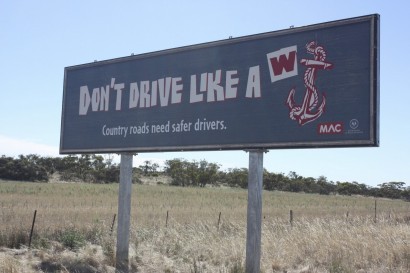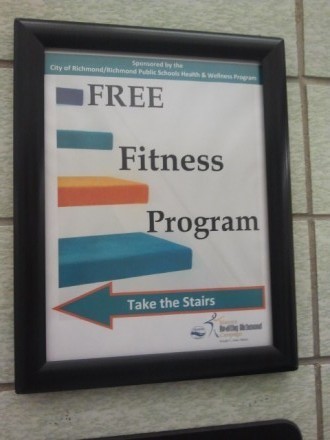Daniel H. Pink's Blog, page 6
August 28, 2012
Are you as bold as this Oregon insurance agency?
Chris Nordyke runs an insurance agency in Corvallis, Oregon. But it’s a different kind of agency — with a unique approach to sales, service, and motivation. Just look at the sign in its lobby.
Share on Facebook
August 16, 2012
4 emotionally intelligent signs from the road
As I mentioned in the last post, summer is a great time for emotionally intelligent signs. One reason is that more people are traveling, camera phones at the ready, as this batch of road photos demonstrates.
Tabitha Core found this pleading sign in a work zone in the suburbs of Durban, South Africa:
On the road to Adelaide, Australia, Andrew Greatrex spotted a bit of, ahem, word play:
Chris Shade discovered that even trucks are getting into the act:

And reader Michael Gray found himself on a highway in Indiana behind a truck with a startling (but effective) reminder:
Share on Facebook
July 30, 2012
4 emotionally intelligent (and psychologically sophisticated) signs
Summers always bring a bountiful harvest of emotionally intelligent signs — and the steamy summer of 2012 has been no exception. Over the past several weeks, readers have sent in tons of photos, usually taken with their phones, from their travels around the world.
Here’s the first batch of favorites. Look closely and squint with one eye — and you’ll see they (sorta) have underpinnings in behavioral economics and social psychology.
Two signs offered freebies, which Ariely and Anderson tell us can get people to act:
Thanks to Nick Charney, who saw this at City Hall in Richmond, Virginia
 Thanks to Kyle Treadwell of Dallas, Texas
Thanks to Kyle Treadwell of Dallas, Texas
And two framed framed choices in surprising ways that Cialdini and Kahneman might admire:
Thanks to Nick Ashbee of London, UK
Thanks to Laura Lieske
Coming soon: Reader signs from the road — trucks, rest stops, road signs and more!
July 23, 2012
Word of the day: Bildungsurlaub
 The Germans have a word for everything – usually a long, hard-to-pronounce word. Now the country that gave us Götterdämmerung, schadenfreude, and Fahrvergnügen brings us . . . “bildungsurlaub.” The ungainly word roughly translates as “training vacation” — and captures a concept that seems worth emulating or at least taking seriously.
The Germans have a word for everything – usually a long, hard-to-pronounce word. Now the country that gave us Götterdämmerung, schadenfreude, and Fahrvergnügen brings us . . . “bildungsurlaub.” The ungainly word roughly translates as “training vacation” — and captures a concept that seems worth emulating or at least taking seriously.
German law entitles workers to six weeks of paid vacation. But according to a recent story in the Wall Street Journal, it also provides for — I just love saying it — a bildungsurlaub, five paid days off per year to participate in an approved training course.
As the Journal explains:
Workers could take a Chinese course in Beijing or enroll in a computer course in a seaside town. Training doesn’t have to be directly connected to their job, as long as it is approved by the state.
Approved programs . . . include visits to historical sites such as the Nazi concentration camp at Buchenwald or tours of underground bunkers in Berlin. Social volunteering courses, like training to become a life coach, are other options. It is hoped that employers, employees and society will profit from the knowledge and experience gained on training leave.
Employers can say “nein” to requests, and employees must foot the bill themselves — both of which might explain why very few workers actually participate. But I can’t help thinking this notion — or some variation of it — is a powerful idea.
What do you think? Is this a practice more individuals and organizations should consider? Would a bildungsurlaub fit into your Weltanschauung?
July 16, 2012
Are commissions the only way to motivate salespeople?
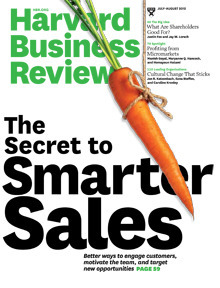 Let’s face it. Salespeople aren’t like the rest of us. You and I want a decent paycheck, of course. But we also seek much more from our work – the chance to learn, to contribute to the world, and to climb the ladder of self-actualization.
Let’s face it. Salespeople aren’t like the rest of us. You and I want a decent paycheck, of course. But we also seek much more from our work – the chance to learn, to contribute to the world, and to climb the ladder of self-actualization.
But not the folks in sales. They are — and here comes the adjective we deploy most often – coin-operated. Slip a quarter into the slot and they’ll do a little dance. When time runs out, insert another coin or they’ll stop dancing.
In the new Harvard Business Review, I’ve got a 2-page article challenging this view. It explains why commissions sometimes backfire — and introduces a few places that have eliminated commissions and seen sales rise.
You can read it here. (Free registration required. UPDATE: Article is now free and outside the firewall.)
***As it happens, this question — Are salespeople different from the rest of us? — was one of the first questions I got from readers after publishing Drive. And I became so interested in the broader topic of selling that for the past year, I’ve been writing a book about the subject — the first book on sales for people who’d never read a book about sales. You’ll be hearing more about that in the coming months in advance of its January launch.
July 9, 2012
Two cities use signs to set the rules (and make a point)
Ahh, summer. A time when some of us descend into the salt mines to finish a big project — while others of us get all Kerouac and hit the open road.
If you’re in that former group, please stop complaining. If you’re in the latter, please bring your camera phone on your journey to take photos of the great (and occasionally emotionally intelligent) signs you see along the way.
For guidance, check out the two shots below. The first comes from Greg Hollmann, whose daughter is doing a summer internship in Homer, Alaska (pop. 5003). The second is from Kurt (last name omitted for obvious reasons) who visited Stockton, California (pop. 291,707) — and got out of town as quickly as he could.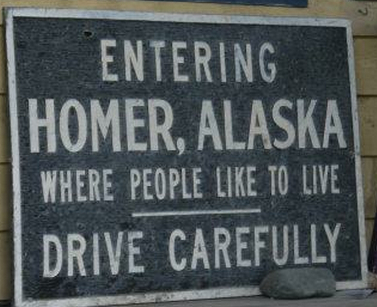
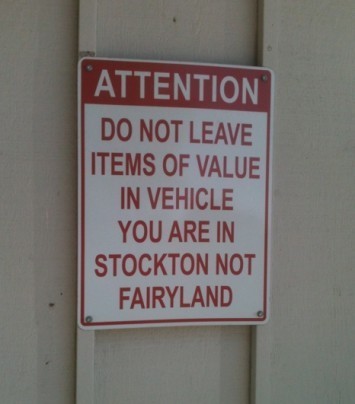 (Note: Apparently, the first thing creditors claimed under Stockton’s recent bankruptcy filing was the city’s rich trove of punctuation marks.)
(Note: Apparently, the first thing creditors claimed under Stockton’s recent bankruptcy filing was the city’s rich trove of punctuation marks.)
If you’ve got emotionally intelligent signage of your own, please send me photos. Tens of thousands of Pink Blog readers want to see them.
June 28, 2012
Ask Dan Ariely anything you want — Friday on Office Hours
 Duke University professor of behavioral economics Dan Ariely has already schooled us on irrationality. Now he’s back to educate us on — no lie — dishonesty.
Duke University professor of behavioral economics Dan Ariely has already schooled us on irrationality. Now he’s back to educate us on — no lie — dishonesty.
Join us Friday, June 29, at 1pm EDT for the next episode of Office Hours, when we’ll be talking to Ariely (that’s him to your right, sipping wine) about his fascinating new book, The Honest Truth about Dishonesty. Just dial (703) 344-2171 x203373 to listen live. Once you’re on, you’ll be able to ask Ariely anything you want — and he might even give you an honest answer.
While you’re waiting for the show (which we like to call “Car Talk…for the Human Engine”) you might want to give Ariely’s new iPhone app a whirl. It’s called Conscience+, it’s free, and it’s meant to make tough decisions a little bit easier — or at least more fun.
So join us this Friday, June 29, at 1pm EDT — and have your questions ready! As always, Office Hours is free of charge and free of advertising. Previous episodes are available for download here or from iTunes.
June 26, 2012
The 3 quotations I keep on my office wall
 Some of you asked. Here’s the answer:
Some of you asked. Here’s the answer:
“Live as if you were living already for the second time and as if you had acted the first time as wrongly as you are about to act now.”
– Viktor Frankl
“Remembering that you are going to die is the best way I know to avoid the trap of thinking you have something to lose.”
– Steve Jobs
“Being a professional is doing the things you love to do — even on the days you don’t feel like doing it.”
– Julius Erving
June 25, 2012
How to avoid being “netflixed”: 5 questions for Saul Kaplan
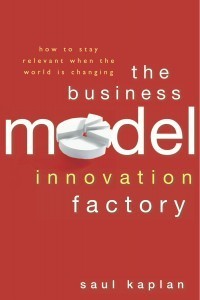
My pal Saul Kaplan is a self-confessed innovation junkie. That’s all he seems to think, talk, and tweet about (with occasional detour for Boston sports teams.) He’s the founder and chief catalyst of the Business Innovation Factory in Providence and the proprietor of the most excellent annual conference of the same name.
Now he’s taken the wisdom he’s acquired over the years and turned it into a book about an urgent, but often overlooked, topic: Business models. In The Business Model Innovation Factory: How to Stay Relevant When the World is Changing (Buy it at Amazon, BN.com, or IndieBound), Kaplan outlines a set of principles that individuals and organizations can enlist to avoid getting steamrollered by competitors who do somewhat similar things but in distinctly different ways.
Because the book is so relevant to the issues many of us confront, I asked Saul to answer a few questions for Pink Blog readers:
You start off your book by saying “The goal for all leaders is to avoid being netflixed.” Could you explain a little bit about what it means to be “netflixed”?
Being netflixed means the way you do business today is disrupted, displaced, or destroyed by a competitor who plays by an entirely new set of rules. Blockbuster was netflixed. It was stuck in a bricks and mortar business model and was obliterated by the upstart Netflix. Today all companies, even Netflix, are vulnerable to being netflixed. Business models don’t last as long as they used to. The imperative for all leaders is to experiment with new business models even the disruptive ones.
In your experience, do companies usually see disruptive innovation and underestimate it, or are companies completely blind to it? How can we become more attuned to changes ahead?
Companies fail at avoiding disruption because they are so busy pedaling the bicycle of their current business model. They leave no time or resources to design, prototype, and test new ones. Every new technology is seen as a way to make the existing business model stronger rather than enabling entirely new ones. It’s not that companies don’t see disruption on the horizon, it’s that they wrongly think they can lean against it or prevent it. Companies need sandboxes to make it safe and more manageable to play with disruptive approaches. If you don’t learn how to disrupt yourself, someone else will.
One of your key points is that business model innovation has to involve the end user or the customer. Has social media made this process easier? How do you screen out the noise?
The only way to go from tweaks to transformation is to change your lens. Instead of viewing opportunities through the lens of your business model, adopt the lens of your customer. Don’t just understand customer experience. Engage them directly in the design of new business models. Social media can unleash entirely new business models, but most companies still treat it as an extension to marketing and communication departments. It’s bigger than that. All business is social. Curation and filtering become important organizational capabilities to create more signal and less noise.
You say at one point that “products and services that meet customer needs but with small initial market potential…are discarded,” leaving a gap for competitors to rush in and fill. Given a choice, would you choose to have lots and lots of customers, or a small group of very loyal customers?
Companies always establish financial hurdles that make it difficult to experiment with new ways to meet unmet customer needs. Once competitors swoop in and get a market foothold, they inevitably come after your core customers. Given a choice, I want engaged customers. I want to deliver experiences that customers are passionate about. I would rather have a solid base of committed customers, motivated to spread the word about their experience, to build from. Far too many companies lack real engagement with their customers, leaving them vulnerable to competitors who are creating more of a movement than a company. Think Apple, Zappos and 37 Signals.
What is one thing the innovative readers of this blog could do today to get their great ideas out of their heads, off their whiteboards, and into real-world testing?
I use the technical term: “We need to try more stuff!” My mantra is, think big, start small and scale fast. Somewhere along the way we’ve become afraid of trying. We don’t like to fail. I don’t know how you learn anything new if you don’t experiment all the time. We should reframe failure as intentional iteration! We have to reinvent ourselves several times over the course of our lives and careers. The goal is to get better faster. We also need to learn how to think and act more horizontally. We need to get out of our silos. I like to say we need to enable more random collisions of unusual suspects. The gold and best value creating opportunities are in the gray areas between us.
How to avoid being “nextflixed”: 5 questions for Saul Kaplan

My pal Saul Kaplan is a self-confessed innovation junkie. That’s all he seems to think, talk, and tweet about (with occasional detour for Boston sports teams.) He’s the founder and chief catalyst of the Business Innovation Factory in Providence and the proprietor of the most excellent annual conference of the same name.
Now he’s taken the wisdom he’s acquired over the years and turned it into a book about an urgent, but often overlooked, topic: Business models. In The Business Model Innovation Factory: How to Stay Relevant When the World is Changing (Buy it at Amazon, BN.com, or IndieBound), Kaplan outlines a set of principles that individuals and organizations can enlist to avoid getting steamrollered by competitors who do somewhat similar things but in distinctly different ways.
Because the book is so relevant to the issues many of us confront, I asked Saul to answer a few questions for Pink Blog readers:
You start off your book by saying “The goal for all leaders is to avoid being netflixed.” Could you explain a little bit about what it means to be “netflixed”?
Being netflixed means the way you do business today is disrupted, displaced, or destroyed by a competitor who plays by an entirely new set of rules. Blockbuster was netflixed. It was stuck in a bricks and mortar business model and was obliterated by the upstart Netflix. Today all companies, even Netflix, are vulnerable to being netflixed. Business models don’t last as long as they used to. The imperative for all leaders is to experiment with new business models even the disruptive ones.
In your experience, do companies usually see disruptive innovation and underestimate it, or are companies completely blind to it? How can we become more attuned to changes ahead?
Companies fail at avoiding disruption because they are so busy pedaling the bicycle of their current business model. They leave no time or resources to design, prototype, and test new ones. Every new technology is seen as a way to make the existing business model stronger rather than enabling entirely new ones. It’s not that companies don’t see disruption on the horizon, it’s that they wrongly think they can lean against it or prevent it. Companies need sandboxes to make it safe and more manageable to play with disruptive approaches. If you don’t learn how to disrupt yourself, someone else will.
One of your key points is that business model innovation has to involve the end user or the customer. Has social media made this process easier? How do you screen out the noise?
The only way to go from tweaks to transformation is to change your lens. Instead of viewing opportunities through the lens of your business model, adopt the lens of your customer. Don’t just understand customer experience. Engage them directly in the design of new business models. Social media can unleash entirely new business models, but most companies still treat it as an extension to marketing and communication departments. It’s bigger than that. All business is social. Curation and filtering become important organizational capabilities to create more signal and less noise.
You say at one point that “products and services that meet customer needs but with small initial market potential…are discarded,” leaving a gap for competitors to rush in and fill. Given a choice, would you choose to have lots and lots of customers, or a small group of very loyal customers?
Companies always establish financial hurdles that make it difficult to experiment with new ways to meet unmet customer needs. Once competitors swoop in and get a market foothold, they inevitably come after your core customers. Given a choice, I want engaged customers. I want to deliver experiences that customers are passionate about. I would rather have a solid base of committed customers, motivated to spread the word about their experience, to build from. Far too many companies lack real engagement with their customers, leaving them vulnerable to competitors who are creating more of a movement than a company. Think Apple, Zappos and 37 Signals.
What is one thing the innovative readers of this blog could do today to get their great ideas out of their heads, off their whiteboards, and into real-world testing?
I use the technical term: “We need to try more stuff!” My mantra is, think big, start small and scale fast. Somewhere along the way we’ve become afraid of trying. We don’t like to fail. I don’t know how you learn anything new if you don’t experiment all the time. We should reframe failure as intentional iteration! We have to reinvent ourselves several times over the course of our lives and careers. The goal is to get better faster. We also need to learn how to think and act more horizontally. We need to get out of our silos. I like to say we need to enable more random collisions of unusual suspects. The gold and best value creating opportunities are in the gray areas between us.


